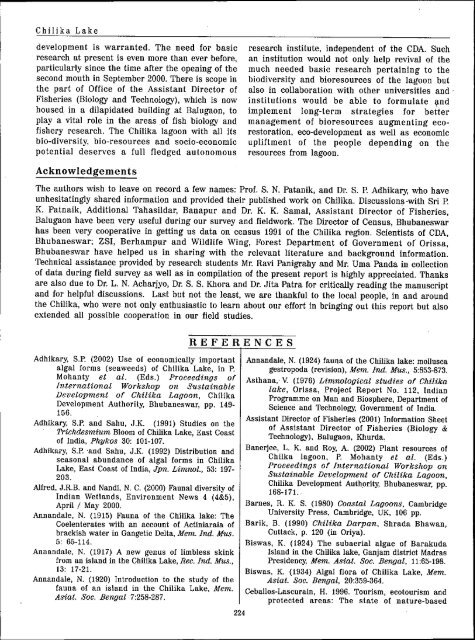06-bioresourcesstatu.. - M. S. Swaminathan Research Foundation
06-bioresourcesstatu.. - M. S. Swaminathan Research Foundation
06-bioresourcesstatu.. - M. S. Swaminathan Research Foundation
You also want an ePaper? Increase the reach of your titles
YUMPU automatically turns print PDFs into web optimized ePapers that Google loves.
Chilika Lake<br />
development is warranted. The need for basic<br />
research at present is even more than ever before,<br />
particularly since the time after the opening of the<br />
second mouth in September 2000. There is scope in<br />
the part of Office of the Assistant Director of<br />
Fisheries (Biology and Technology), which is now<br />
housed in a dilapidated building at Balugaon, to<br />
play a vital role in the areas of fish biology and<br />
fishery research. The Chilika lagoon with all its<br />
bio-diversity, bio-resources and socio-economic<br />
potential deserves a full fledged autonomous<br />
Acknowledgements<br />
research institute, independent of the CDA. Such<br />
an institution would not only help revival of the<br />
much needed basic research pertaining to the<br />
biodiversity and bioresources of the lagoon but<br />
also in collaboration with other universities and'<br />
institutions would be able to formulate {lnd<br />
implement long-term strategies for better<br />
management of bioresources augmenting ecorestoration,<br />
eco-development as well as economic<br />
upliftment of the people depending on the<br />
resources from lagoon.<br />
The authors wish to leave on record a few names: Prof. S. N. Patanik, and Dr. S. P. Adhikary, who have<br />
unhesitatingly shared information and provided their published work on Chilika. Discussions -with Sri P.<br />
K. Patnaik, Additional Tahasildar, Banapur and Dr. K. K. Samal, Assistant Director of Fisheries,<br />
Balugaon have been very useful during our survey and fieldwork. The Director of Census, Bhubaneswar<br />
has been very cooperative in getting us data on census 1991 of the Chilika region. Scientists of CDA,<br />
Bhubaneswar; ZSI, Berhampur and Wildlife Wing, Forest Department of Government of Orissa,<br />
Bhubaneswar have helped us in sharing with the relevant literature and background information.<br />
Technical assistance provided by research students Mr. Ravi Panigrahy and Mr. Uma Panda in collection<br />
of data during field survey as well as in compilation of the present report is highly appreciated. Thanks<br />
are also due to Dr. L. N. Acharjyo, Dr. S. S. Khora and Dr. Jita Patra for critically reading the manuscript<br />
and for helpful discussions. Last but not the least, we are thankful to the local people, in and around<br />
the Chilika, who were not only enthusiastic to learn about our effort in bringing out this report but also<br />
extended all possible cooperation in our field studies.<br />
REFERENCES<br />
Adhikary, S.P. (2002) Use 01 economically important<br />
algal forms (seaweeds) of Chilika Lake, in P.<br />
Mohanty et al. (Eds.) Proceedings of<br />
International Workshop on Sustainable<br />
Development of Chilika Lagoon, Chilika<br />
Development Authority, Bhubaneswar, pp. 149-<br />
156.<br />
Adhikary, S.P. and Sahu, J.K. (1991) Studies on the<br />
Trichdesmium Bloomof Chilika Lake, East Coast<br />
of India, Phykos 30: 101-107.<br />
Adhikary, S.P.'and Sahu, J.K. (1992) Distribution and<br />
seasonal abundance of algal forms in Chilika<br />
Lake, East Coast of India, Jpn. Limnol., 53: 197-<br />
203.<br />
Alfred.J.R.B. and Nandi, N. C. (2000)Faunal diversity of<br />
Indian Wetlands, Environment News 4 (4&5),<br />
April / May 2000.<br />
Annandale, N. (1915) Fauna of the Chilika lake: The<br />
Coelenterates with an account of Actiniaraia of<br />
brackish water in Gangetic Delta,Mem. Ind. Mus.<br />
5: 65-114.<br />
Annandale, N. (1917) A new genus of limbless skink<br />
from an island in the Chilika Lake,Rec.Ind. Mus.,<br />
13: 17-21.<br />
Annandale, N. (1920) Introduction to the study of tbe<br />
fauna of an island in the Chilika Lake, Mem.<br />
Asiat. Soc. Bengal 7:258-287.<br />
224<br />
Annandale, N. (1924)fauna of the Chilika lake: mollusca<br />
gestropoda (revision), Mem. Ind. Mus., 5:853-873.<br />
Asthana, V. (1976) Limnological studies of Chilika<br />
lake, Orissa, Project Report No. 112, Indian<br />
Programme on Man and Biosphere, Department of<br />
Science and Technology,Government of India.<br />
Assistant Director of Fisheries (2001)Information Sheet<br />
of Assistant Director of Fisheries (Biology &<br />
Technology),Balugaon, Khurda.,<br />
Banerjee, L. K, and Roy, A. (2002) Plant resources of<br />
Chilka lagoon, P. Mohanty et al. (Eds.)<br />
Proceedings of International Workshop on<br />
Sustainable Development of Chilika Lagoon,<br />
Chilika DevelopmentAuth.ority,Bhubaneswar, pp.<br />
168-171.<br />
Barnes, R. K. S. (1980) Coastal Lagoons, Cambridge<br />
University Press, Cambridge, UK, 1<strong>06</strong> pp.<br />
Barik, B. (1990) Chilika Darpan, Shrada Bhawan,<br />
Cuttack, p. 120 (in Oriya).<br />
Biswas, K. (1924) The subaerial algae of Barakuda<br />
Island in the Chilika lake, Ganjam district Madras<br />
Presidency, Mem. Asiat. Soc. Bengal, 11:65-198.<br />
Biswas, K. (1934) Algal flora of Chilika Lake, Mem.<br />
Asiat. Soc. Bengal, 20:359-364.<br />
Ceballos-Lascurain, H. 1996. Tourism, ecotourism and<br />
protected areas: The state of nature-based










